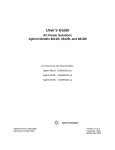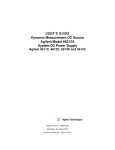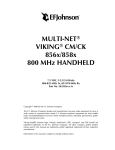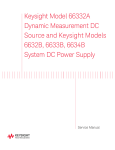Download Agilent Technologies 6552A Specifications
Transcript
5965-8239EE.qxd 3/20/98 3:53 PM Page 1 This literature was published years prior to the establishment of Agilent Technologies as a company independent from Hewlett-Packard and describes products or services now available through Agilent. It may also refer to products/services no longer supported by Agilent. We regret any inconvenience caused by obsolete information. For the latest information on Agilent’s test and measurement products go to: www.agilent.com/find/products Or in the US, call Agilent Technologies at 1-800-452-4844 (8am–8pm EST) 10 Practical tips you need to know about your power products Simple ways to improve your operation and measurement capabilities 5965-8239EE.qxd 3/20/98 3:53 PM Page 2 Tip Use Remote Sensing to Compensate for LoadLead Effects 1 When your power supply leaves the factory, its regulation sense terminals are usually connected to the output terminals. This limits the supply’s voltage regulation abilities, even with very short leads. The longer the leads and the higher the wire gauge, the worse the regulation gets (Figure 1). Compare the output impedance of a well-regulated 10 A supply, which might have an output impedance of 0.2 mΩ with the resistance of copper wire: I3 0.015 Ω lead resistance Power Supply Programmed for 5 V, 10 A S Load 5V 4.7 V S 0.015 Ω lead resistance load leads are 6 foot, AWG 14 Figure 1: The effects of six feet of AWG 14-gauge leads without remote sensing. 0.015 Ω lead resistance Power Supply Programmed for 5 V, 10 A S I2 5.3 V S 0.015 Ω lead resistance load leads are 6 foot, AWG 14 Figure 2: Using remote sensing to correct the lead-load problem. 2 Load 5V AWG wire size 22 20 18 16 14 12 10 Resistance in mΩ/ft (at 20° C) 16.1 10.2 6.39 4.02 2.53 1.59 0.999 And regulation gets even worse if you use a relay to connect power to the load. T3 Remote sensing, in which you connect the sense terminals of the power supply’s internal feedback amplifier directly to the load, lets the power supply regulate its output at the load terminals, rather than at its own output terminals (Figure 2). The supply voltage shifts as necessary to compensate for the resistance of the load leads, relays, or connectors, thereby keeping the voltage at the load constant. To implement remote sensing, disconnect the local sense leads from the output terminals. Use twisted two-wire shielded cable to connect the power supply sensing terminals to the sense points on the load. (Don’t use the shield as one of the sensing conductors.) Connect one end of the shield to ground and leave the other end unconnected. Sensing currents are typically less than 10 mA, and as a general rule, you should keep the voltage drop in the sense leads to less than 20 times the power supply temperature coefficient (usually stated in mV/°C). This is easy to achieve with readily available shielded two-wire cable. 5965-8239EE.qxd 3/20/98 3:53 PM Page 3 Tip Charge and Discharge Batteries in Less Time 2 Using a power supply in constantcurrent mode (Figure 1) is a simple way to recharge batteries, and it also lets you achieve 100% charge levels. On the downside, this method is slow, taking as long as 14-16 hours because the charging current is only a fraction of the battery’s amp/hour rating. Pulse charging, also called transient mode, shortens the charging time, yet still charges the battery to over 90% capacity (Figure 2). The electronic load acts as a switch, providing the current pulses. (Note that you can also use an electronic load to program constant-current charging.) Figure 3 shows a typical pulse-charging current waveform. To simulate battery drain, you can also program the electronic load to discharge batteries with either constant or pulse current waveforms. In some cases, pulse discharging does a better job of mimicking a product’s energy-saving features. Simulating cellular phone battery discharge, for instance, is complex due to the phone’s various operating modes—standby, dialing, and talking. You can create the necessary tri-level discharge current waveform shown in Figure 4 using the electronic load. I I2 Power Supply Battery I1 T Figure 1: Constant current charging is simple and effective, but it can be very slow. (The diode prevents the battery from discharging through the power supply if the supply voltage drops below the battery voltage.) I Electronic Load Power Supply T2 Figure 3: A typical pulse charging waveform created with an electronic load. I3 T4 T3 Battery T1 Figure 2: Pulse charging using an electronic load is much faster, while still achieving 90% recharge. I2 I1 T1 T2 T Figure 4: A complex waveform that simulates the energy-saving features in portable, batterypowered products. 3 5965-8239EE.qxd 3/20/98 3:53 PM Page 4 Tip Increase Safety with Remote Disable Feature 3 Remote disable offers a safe way to shut down a power supply to respond to some particular operating condition or to protect system operators (in response to a cabinet door being opened unexpectedly or someone pushing a panic button, for instance). +5 V To Microprocessor RI Masse DFI From Microprocessor Com Figure 1. Remote inhibit and discrete fault indicator schematic. Remote inhibit (RI) is an input to the power supply that disables the output when the RI terminal is pulled low (Figure 1). Shorting the normally open switch turns off the supply’s output. You could also use a logic chip with an open collector transistor output instead of the switch. Figure 1 also shows the discrete fault indicator (DFI), which you can use to signal an operator or other components in the system whenever the power supply detects a user-defined fault. You can daisy chain DFI and RI as shown in Figure 2. If one supply detects a fault, all supplies in the system are disabled. Using this approach, you can chain together an unlimited number of supplies. Almost any operating condition can create a DFI signal. For example, to generate a DFI signal when the load draws excessive current, RI RI Com Com Power Supply #1 Power Supply #2 DFI DFI RI RI Figure 2. Daisy-chained DFI and RI. 4 enable the over current protection (OCP) mode, program the unit to generate a DFI signal when it enters constant current mode, then program the maximum current the load normally draws. If the load current exceeds the maximum, the DFI output goes low, disables the power supply, and informs the operator of the overcurrent condition (or performs another user-defined function), without tying up the system bus or interrupting the system controller. 5965-8239EE.qxd 3/20/98 3:53 PM Page 5 Tip Eliminate Noise from Low-Level Measurements 4 Noise in low-level measurements can come from a number of different sources, and it’s easier to eliminate noise than to filter it. Check these noise sources: 1. Power Supply Starting with a low-noise supply is naturally a great way to keep noise out of your measurements. Linear power supplies have lower common-mode noise currents, and generally operate at low frequency. However, you can use switchmode supplies successfully if their specifications include a low common-mode current. As a rule of thumb, common-mode current over 20-30 mA is likely to cause trouble. Keep reading for hints on how to minimize the problem. 2. DUT to Power Supply Connections Minimize conducted noise by eliminating ground loops. Ideally, there should be only one connection to Shield C Power Supply Load S S Shield Figure 1: Minimizing radiated pick-up with twisted shield leads for both output and remote sense leads. ground. In rack systems, where multiple ground points are inevitable, separate the dc distribution path from other conductive paths that carry ground currents. If necessary, float the power supply (don’t connect either terminal directly to ground). Minimize radiated pick-up (both electric and magnetic) by using twisted shielded conductors for the output and remote sense leads. To make sure the shield doesn’t carry current, connect the shield to ground at one end only, preferably the single-point ground on the supply (Figure 1). Minimize the power supply’s common-mode noise current by equalizing the impedance to ground from the plus and minus output terminals. Also equalize the DUT’s impedance to ground from the plus and minus input terminals. Magnetic coupling or capacitive leakage provide a return path for noisy ground loop current at higher frequencies. To balance the DUT’s impedance to ground for your test frequencies, use a common-mode choke in series with the output leads and a shunt capacitor from each lead to ground. 3. Current Variations to the DUT Rapid changes in the DUT’s current demand cause voltage spikes. To prevent this, add a bypass capacitor close to the load. The capacitor should have a low impedance at the highest testing frequencies. Avoid imbalances in load lead inductance; direct connections to the DUT, such as twisted shielded pair, are your best bet. 5 5965-8239EE.qxd 3/20/98 3:53 PM Page 6 Tip 5 Use Down Programming to Increase Test Speed Under light or no load conditions, a power supply’s output capacitor discharges slowly. If you’re using the supply as a static voltage source, this is not problematic, but when you’re making tests at varying voltage levels, slow discharge means slow tests. Down programming circuits in power supplies rapidly decrease the output voltage, reducing discharge times by hundreds of milliseconds. Hewlett-Packard power supplies use two types of down programming circuits: Figure 1: A down programming circuit with an FET across the output terminals. • In Figure 1, an FET is placed across the output terminals. Whenever the output voltage is higher than the programmed value, the FET activates and discharges the output capacitor. The FET can sink currents ranging from 10% to 20% of the supply’s output current rating. The maximum load at low voltages is limited to the On resistance of the FET plus the series monitoring resistor, resulting in a slight degradation of the down programming current near zero volts. • In Figure 2, the down programmer lies between the power supply’s positive terminal and a negative source. This configuration pulls the output completely down with no degradation near zero. Some power supplies, such as the HP 662xA and 663xB series, can sink currents equal to their full output current rating. In the HP 663xB series, this sink current is programmable, so you can use the supply both as a programmable source and load—very useful in applications such as charging and discharging batteries. http://www.hp.com/go/power Figure 2: A down programmer situated between power supply’s positive output and a negative source. 6 5965-8239EE.qxd 3/20/98 3:53 PM Page 7 Tip Ensure Proper Power-up with Foldback Supplies 6 Foldback power supplies protect connected equipment by reducing excess current (and thus output voltage) along a foldback path. When testing foldback power supplies using an electronic load, you need to take steps to be sure the power supply starts properly. When using an electronic load in constant resistance mode, the cur- Resistive Load R1 R2 (R2 < R)1 Foldback Region Figure 1: Foldback behavior in constant resistance mode. Constant Current Load I1 rent increases as the resistance decreases, R1 to R2, until the current limit is reached; after that, the supply reduces its output current along the foldback path (Figure 1). For constant current load, the power supply operates in constant voltage mode while the electronic load operates in constant current mode. When the power supply starts up, its output voltage is zero, and the electronic load tries to satisfy the programmed current value (I1) by decreasing the load resistance. The power supply interprets the low load value as an over-current condition, and immediately folds back to a stable operating point (P2 or P3 in Figure 2, depending on the power supply’s startup characteristics). To alleviate this problem, program the electronic load to a value below the current limit foldback point (Imin). This value can be close to zero on many supplies. After applying power to the source, increase the load’s current limit to the desired value. For power supplies that don’t require a minimum load current at all times, you can initially program the load in constant resistance mode. Then, when the power supply reaches its nominal operating voltage, switch the electronic load to constant current mode. (During the transition, the load momentarily goes to zero.) Foldback Region I min Figure 2: Foldback behavior for constant current load. 7 R 5965-8239EE.qxd 3/20/98 3:53 PM Page 8 Tip Connect Power Supplies in Series or Parallel for Higher Output 7 Connecting two or more power supplies in series (Figure 1) provides higher voltages, but observe these precautions: Power Supply #1 • Never exceed the floating voltage rating of any of the supplies. • Never subject any of the power supplies to negative voltages. EM Power Supply #1 E1 Power Supply #1 E2 EL Program each power supply independently. If two supplies are used, program each one for 50% of the total output voltage. If three supplies are used, program each supply for about 33% of the total output voltage. Set the current limit of each supply to the maximum that the load can safely handle. RL Connecting two or more power supplies in parallel (Figure 2) provides higher currents, but again, observe these precautions: EL=EM+E1+E2 • One unit must operate in constant voltage (CV) mode and the other(s) in constant current (CC) mode. • The output load must draw enough current to keep the CC unit(s) in CC mode. Figure 1: Connecting units in series. Power Supply #1 Power Supply #2 IM Power Supply #3 I1 I2 IL RL IL=IM+I1+I2 Figure 2: Connecting units in parallel. 8 Program the current limit of each unit to its maximum value and program the output voltage of the CV unit to a value slightly lower than the CC unit(s). The CC units supply the maximum output current that they have been set to and drop their output voltage until it matches the voltage of the CV unit, which supplies only enough current to fulfill the total load demand. 5965-8239EE.qxd 3/20/98 3:53 PM Tip 8 Page 9 Use Your Power Supply to Measure Pulsed Current To adequately specify the power source for products that exhibit pulsed and dynamic current loading (such as digital cellular phones and hard drives), you need to evaluate both the peak and dc averages current draws. You could use an oscilloscope to monitor a shunt or a current probe, but this approach raises issues with voltage drops, ground loops, common mode noise, space, and calibration. As a simpler and cheaper alternative, use a power supply with builtin measurement capabilities. The HP 66312B and 66332B dynamic measurement dc sources store up to 4,096 data points at sample intervals from 15.6 ms to 31,200 s. Like an oscilloscope, they acquire pre- and post-trigger buffer data by crossing a user-set threshold. These dynamic measurement capabilities are illustrated in an HP VEE program output panel (Figure 1). In Figure 2, note the SCPI commands in the “Set Up Source,” “Measure” and “Enter Array” blocks. (You can use these commands in other programming environments as well.) Note that “MEAS” can be used in place of “FETC” to cause an immediate trigger. Obtain subsequent measurement parameters from the same data by using “FETC.” Figure 1. An HP VEE program that makes parametric measurements and captures the pulse current loading of a digital cellular phone. Figure 2. Block flow diagram of the HP VEE program, showing program details. 9 5965-8239EE.qxd 3/20/98 3:53 PM Tip Page 10 Characterize Inrush Current with an AC Power Source/Analyzer 9 The inrush current characteristics of ac-dc switch mode power supplies vary with the turn-on phase of the voltage cycle. Usually, these power supplies have input capacitors that draw high peaks of inrush current as they charge from the rectified ac line at turn-on. Characterizing inrush current versus turn-on phase can provide some important design insights: Output Voltage Start up phase of 40 degrees Bus Trigger Inrush Current Peak Current Measurement Digitized Inrush Current Data Points Figure 1: An inrush current measurement at 40° using HP 6800 series ac power source/analyzers. 10 • Uncover component stresses • Check to see if a product produces ac mains disturbances that interact with other products connected to the same branch circuit • Select proper fuses and circuit breakers However, this can be a challenging measurement because you have to synchronize the current digitization and peak current measurement with the startup phase of the voltage. Worst case inrush currents occur near the voltage cycle’s peak and when the ac input capacitor of the DUT is fully discharged at startup. Therefore, you must perform tests at incremental voltage startup phases from around 40° to 90° (Figure 1) and let the DUT’s ac input capacitor discharge between tests. A traditional test setup includes an ac source with programmable phase capability and an output trigger port, a digital oscilloscope, and a current probe. However, using an advanced ac power source/analyzer such as the HP 6800 series ac power source/analyzers is easier because they have built-in generation, current waveform digitization, peak current measurement and synchronization capabilities that let you perform inrush current characterization without cabling and synchronizing separate instruments. 5965-8239EE.qxd 3/20/98 3:53 PM Tip 10 Page 11 Use a Power Supply to Measure DUT Supply Current Accurately measuring DUT supply currents above 10 A is beyond the range of the typical DMM in ammeter mode. You could use an external shunt and the DMM’s voltage mode, but using the power supply itself is a better solution. Many supplies include an accurate measurement system, including a shunt. Using the power source’s shunt to take current or voltage measurements at the DUT can be as simple as sending a MEAS command. The following table shows the level of measurement accuracy you can expect with a good-quality supply: Output level Full 10% of full output 1% of full output Typical accuracy 0.1% to 0.5% 0.5% to 1% near 10% While the advantages of using the power source to measure high currents is clear, using it to measure low currents may not be as obvious. A system DMM has 0.01% to 0.1% accuracy, although this doesn’t include other possible errors that can affect the measurement, such as cabling. In contrast, the power supply accuracy figures in the table include all applicable factors. mode (such as a cellular phone), where measuring 1-10 mA with reasonable accuracy is usually all you need. Most power supplies’ current readback performs well between full scale and 10% of full scale. Newer power sources, such as the HP 66000A modular power system, offer full scale accuracy of 0.06% at 16 A and 3.8% accuracy at 160 mA. You can also choose a power supply with multiple range readback. The HP 663XA series can measure as low as 2.5 µA and offers accuracy of 5.1% at 50 µA (with full-scale accuracy of 0.2%). Also, keep in mind that while ac sources offer many current measurement options, including rms, newer dc sources, such as the HP 66312B and 66332B, provide rms peak measurements as well (see Tip 8 ). A good system DMM can measure current down to the picoamp level, but you rarely need to measure DUT supply currents this low. In most cases, the toughest measurement will involve current draw by a battery-powered device in sleep 11 5965-8239EE.qxd 3/20/98 3:53 PM Page 12 Power products that do more and demand less. HP’s “one-box” philosophy means we pack more and more capability into the power products themselves, in some cases giving you a rack’s worth of capability in a single box. By offering more, these products demand less from you—fewer instruments, less rack space, simpler test setups, and lower cost of ownership. Dynamic measurement dc supplies The HP 66312B and 66332B are the first power supplies with instantaneous peak measurement capability, so you no longer need a scope or high-speed digital voltmeter to test devices that draw pulsed current. • Precision current measurement—as low as 0.6 µA • Dynamic voltage measurements accurate to 0.03% + 5 mV • Dynamic current measurements accurate to 0.6% + 1 mA (HP 66312B) Solar array simulator The HP E4350A solar array simulator mimics the output characteristics of a satellite’s solar panels. It’s also a great example of our ability to create unique power solutions to meet unique application challenges. • Simulate I-V curves of a solar array under various conditions • Operate the system in three different modes for maximum flexibility • Available as individual power modules or as a turnkey system customized to your needs Autoranging dc supplies The HP 6030-series autoranging supplies are a flexible, convenient solution when you need to test a wide range of devices with a single supply or test devices with a variety of operating points. • Choose from six models with power ratings from 200 W to 1 kW • All models offer HP’s one-box solution with built-in readback • Current ranges from 2 to 120 A; voltage ranges from 6.7 to 500 V DYNAMIC MEASUREMENT DC SUPPLIES Model Voltage Current Maximum power HP 66312B 0 to 20 V 0 to 2 A 40W HP 66332B 0 to 20 V 0 to 5 A 100W SOLAR ARRAY SIMULATORS Model Voltage Current Maximum power E4350B 0 to 65 V 0 to 8 A 480W E4351A 0 to 130 V 0 to 4 A 480W AUTO-RANGING SUPPLIES Model Voltage Current Maximum output power at any valid combination of V and I 12 HP 6033A 0 to 20 V 0 to 30 A HP 6038A 0 to 60 V 0 to 10 A HP 6030A 0 to 200 V 0 to 17 A HP 6031A 0 to 20 V 0 to 120 A HP 6032A 0 to 60 V 0 to 50 A HP 6035A 0 to 500 V 0 to 5 A 200 W 200 W 1000 W 1000 W 1000 W 1000 W 5965-8239EE.qxd 3/20/98 3:53 PM Page 13 Power you can count on year after year. We’ve been a leader in the power products business for more than three decades because engineers like you know they can count on HP performance, reliability and value. Even our least-expensive dc sup- Single-output dc supplies These supplies will clean up your ATE power without cleaning out your budget. Not only do you buy more performance with the HP 6600-series, their one-box integration means you’ll buy less equipment overall, too. plies offer low ripple and noise with tight load and line regulation. Our high-precision products give you the exact power levels you need, with accurate readback measurements to match. Plus, every product you see • Clean, reliable dc power from 40 W to 5 kW • Designed for fast, easy system integration • Built-in V & I readback for onebox convenience here is covered by a three-year warranty. To learn more about these power solutions, please visit our Web site at http://www.hp.com/go/power. For immediate service, call HP DIRECT at one of the telephone numbers listed on the back page. SINGLE-OUTPUT DC SUPPLIES 40 W Voltage Current 100 W Voltage Current 200 W Output voltage Output current (40° C) Maximum current (50° C) Maximum current (55° C) 500 W Output voltage Ouput current (40° C) Maximum current (50° C) Maximum current (55° C) 2 kW Output voltage Output current 5 kW Voltage Current (derated linearly 1%/° C to 55° C) HP 6611C HP 6612C HP 6613C HP 6614C 0 to 8 V 0 to 5 A 0 to 20 V 0 to 2 A 0 to 50 V 0 to 1 A 0 to 100 V 0 to 0.5 A HP 6631B 0 to 8 V 0 to 10 A HP 6632B 0 to 20 V 0 to 5 A HP 6633B 0 to 50 V 0 to 2 A HP 6634B 0 to 100 V 0 to 1 A HP 6541A* HP 6641A 0 to 8 V 0 to 20 A 18.0 A 17.0 A HP 6542A* HP 6642A 0 to 20 V 0 to 10 A 9.0 A 8.5 A HP 6543A* HP 6643A 0 to 35 V 0 to 6 A 5.4 A 5.1 A HP 6544A* HP 6644A 0 to 60 V 0 to 3.5 A 3.2 A 3.0 A HP 6545A* HP 6645A 0 to 120 V 0 to 1.5 A 1.4 A 1.3 A HP 6551A* HP 6651A 0 to 8 V 0 to 50 A 45.0 A 42.5 A HP 6552A* HP 6652A 0 to 20 V 0 to 25 A 22.5 A 21.3 A HP 6553A* HP 6653A 0 to 35 V 0 to 15 A 13.5 A 12.8 A HP 6554A* HP 6654A 0 to 60 V 0 to 9 A 8.1 A 7.7 A HP 6555A* HP 6655A 0 to 120 V 0 to 4 A 3.6 A 3.4 A HP 6571A* HP 6671A 0 to 8 V 0 to 220 A HP 6572A* HP 6672A 0 to 20 V 0 to 100 A HP 6573A* HP 6673A 0 to 35 V 0 to 60 A HP 6574A* HP 6674A 0 to 60 V 0 to 35 A HP 6575A* HP 6675A 0 to 120 V 0 to 18 A HP 6680A HP 6681A HP 6682A HP 6683A HP 6684A 0 to 5 V 0 to 8 V 0 to 21 V 0 to 32 V 0 to 40 V 0 to 875 A 0 to 580 A 0 to 240 A 0 to 160 A 0 to 128 A *Economy versions with identical specifications, but without HP-IB. 13 5965-8239EE.qxd 3/20/98 3:54 PM Page 14 Power products that do more and demand less. Multiple-output dc supplies The HP 6620-series’ multiple outputs and integrated I & V readback dramatically simplify the job of system integration and maintenance. Plus, the HP 6625A, 6626A, 6628A and 6629A models offer the precision of 14-bit dual range programming and readback. Modular power system With rack space at a premium, the HP 66000 modular power system’s growing popularity is no surprise. A single mainframe can hold up to eight modules, and you can choose from six modules with voltage ranges up to 200 V and current ranges up to 16 A. • Choose 2, 3 or 4 independent, isolated outputs • Precision programming and readback • Built-in readback for one-box convenience and value • High power density—up to eight supplies in seven inches of rack space • Low noise, stable power • High accuracy programming and readback Electronic Loads HP’s integrated electronic loads help you save time, money and rack space while delivering precise control and all the capabilities you need for analyzing dc power sources and devices. Use the programable pulse waveform generator or use analog programming to simulate real-life load conditions. • Ideal for evaluating dc power sources and power components • Lower costs while improving ease of use and test quality • Single-input and modular units with proven record of reliability MULTIPLE-OUTPUT DC SUPPLIES Model 40-W output Low-range volts, amps 0 to 7 V, 0 to 5 A High-range volts, amps 0 to 20 V, 0 to 2 A Output combinations for each model (total number of outputs) HP 6621A (2) — HP 6622A (2) — HP 6623A (3) 1 HP 6624A (4) 2 HP 6627A (4) — 40-W output 0 to 20 V, 0 to 2 A 0 to 50 V, 0 to 0.8 A 80-W output 0 to 7 V, 0 to 10 A 0 to 20 V, 0 to 4 A 80-W output 0 to 20 V, 0 to 4 A 0 to 50 V, 0 to 2A — — 1 2 4 2 — 1 — — — 2 — — — PRECISION MULTIPLE-OUTPUT SUPPLIES Model Output power 25-W output Output range Low range High range Output volts 0 to 7 V 0 to 50 V Output amps 0 to 15 mA 0 to 500 mA Output combinations for each model (total number of outputs) HP 6625A (2) 1 HP 6626A (4) 2 HP 6628A (2) 0 HP 6629A (4) 0 50-W output Low range High range 0 to 16 V 0 to 50 V or 0 to 16 V 0 to 200 mA 0 to 1 A or 0 to 2 A 1 2 2 4 MODULAR POWER SYSTEMS Model Output ratings at 40° C Output voltage Output current Maximum power HP 66101A HP 66102A HP 66103A HP 66104A HP 66105A HP 66106A 0 to 8 V 0 to 16 A 128 W 0 to 20 V 0 to 7.5 A 150 W 0 to 35 V 0 to 4.5 A 157.5 W 0 to 60 V 0 to 2.5 A 150 W 0 to 120 V 0 to 1.25 A 150 W 0 to 200 V 0 to 0.75 A 150 W ELECTRONIC LOADS Model Input voltage Maximum power 14 HP 6060B HP 60502B 3-60 V 300 W HP 6063B HP 60503B 3-240 V 250 W HP 60501B HP 60504B HP 60507 3-60 V 150 W 3-150 V 600W 3-150 V 500 W 5965-8239EE.qxd 3/20/98 3:54 PM Page 15 AC power source/analyzers From avionics to uninterruptible power supplies, customers are demanding products that can use power efficiently while handling all kinds of ac line disturbances. To make sure your products meet these growing expectations, test them with the HP 6800-series ac power source/analyzers. • The fast, easy way to generate both clean and distorted ac power for product testing • A complete solution in a single, compact, tightly integrated box with graphical user interface • Built-in 16-bit power analyzer precisely measures all important parameters Harmonic/flicker test systems The HP 6840-series harmonic/ flicker test systems transform an expensive headache into a competitive advantage. Instead of sending prototypes out to a test lab and waiting for the results, you can now afford to do your own compliance testing—whenever and wherever you need. • Compliance-level testing of IEC low-frequency emission standards • An inexpensive, integrated solution that is easier to install, use and maintain • Advanced diagnostics go beyond simple pass/fail to help you modify designs quickly We’ve combined a precision ac source with built-in power analysis, flickermeter, complete testing and reporting software, and our in-depth knowledge of the IEC standards. The result is much less expensive and easier to maintain than traditional testers built from separate instruments. The HP 6840 test system is easy to set up and the graphical software is easy to use, so you don’t need to be a compliance expert to get dependable results. You’ll have both real-time and off-line data analysis and review, plus report generation and data archiving for thorough test documentation. AC POWER SOURCE/ANALYZERS Model Max power # of phases HP 6811A 375 VA 1 HP 6812A 750 VA 1 HP 6813A 1750 VA 1 HP 6814B 3000 VA 1 HP 6834B 4500 VA 1/3 HARMONIC FLICKER TEST SYSTEMS Model Max power # of phases HP 6841A 750 VA 1 HP 6842A 1750 VA 1 HP 6843A 4800 VA 1 For more information, please visit our Web site at http://www.hp.com/go/power, or call HP DIRECT in your country. Telephone numbers listed on back page. 15 5965-8239EE.qxd 3/20/98 3:54 PM Page 16 HP DIRECT Contact Information To talk with one of our Knowledgeable sales engineers, for more information, or to place your order contact HP DIRECT. Austria Hewlett-Packard HP DIRECT Österreich Schickardstrasse 2 D-71034 Böblingen Deutschland ZUM ORTSTARIF aus Österreich: Tel: 0660 8004 Fax: 0660 8005 Belgium Hewlett-Packard Belgium SA/NV Test and Measurement Boulevard de la Woluwe 100-102 B-1200 Brussels Tel: 02 778 3417 Fax: 02 778 3414 Czech Republic T&M Direct, Sro. Technická 2 CZ-166 27 Praha 6 Tel: 02 2435 5808 Fax: 02 2435 5809 Denmark Hewlett-Packard A/S T&M Direct Kongevejen 25 3460 Birkerød Denmark Tel: 45 99 15 15 Fax: 45 82 06 30 Finland Hewlett-Packard Oy HP TMO Direct PL 68 02201 Espoo Tel: (09) 8872 2100 Fax: (09) 8872 2923 France Hewlett-Packard France HP DIRECT Test et Mesure B. P. 19 91947 Les Ulis Cedex Tel: (1) 69.29.41.14 Fax: (1) 69.82.65.09 Germany Hewlett-Packard GmbH HP DIRECT Schickardstraße 2 71034 Böblingen Tel: (0 70 31) 14 63 33 Fax: (0 70 31) 14 63 36 Greece G-SYSTEMS 76, Ymittou Street 11634 ATHENS Tel: 01 726 40 45 Fax: 01 726 40 20 Hungary Invent Medical Furedi ut. 72-74 HU-4027 Debrecen Tel: 06-52 415580 Fax: 06-52 415580 Ireland Hewlett-Packard Ireland Ltd. HP DIRECT Hewlett-Packard House Stradbrook Road Blackrock Co. Dublin Tel: 01 615 8222 Fax: 01 284 5134 Israel C.M.S. LTD. 11, Hashelosha St. Tel-Aviv 67060 Tel: 03 53 80 377 Fax: 03 53 76 505 Italy Hewlett-Packard Italiana S.p.A HP DIRECT Strumenti di Misura Via G. di Vittorio 9 20063 Cernusco S/N MI Tel: 02.92.122.241 Fax: 02.92.104.069 Netherlands Hewlett-Packard Nederland BV HP T&M DIRECT Startbaan 16 1187 XR Amstelveen Tel: 020 547 6222 Fax: 020 547 7765 Norway Hewlett-Packard Norge A/S T&M Direkte Drammensveien 169 P.O. Box 60 Skøyen N-0212 Oslo Tel: 22 73 57 59 Fax: 22 73 56 19 Poland Malkom Ul Ciolka 8 PL-01-402 Warszawa Tel: 48 22 360072 Fax: 48 22 360072 South Africa Hewlett-Packard Private Bag Wendywood 2144 Tel: 00800/11 68 38 Fax: 011/806 1213 Spain Hewlett-Packard Española, S.A. HP DIRECT Ctra. N-V1, KM 16,500 28230 Las Rozas, Madrid Tel: (91) 631 13 23 Fax: (91) 631 14 69 Sweden Hewlett-Packard Sverige AB Test & Mätsystem Kundcenter Box 19 164 93 Kista Tel: 08 444 2277 Fax: 08 444 2525 Switzerland (German speaking) Hewlett-Packard GmbH HP DIRECT Schweiz Schickardstrasse 2 D-71034 Böblingen Deutschland Tel: 01-735 72 00 Fax: 01-735 72 90 Switzerland (French speaking) Hewlett-Packard HP DIRECT Swiss Test et Mesure B. P. 19 91947 Les Ulis Cedex France Tel: 022-780 44 85 Fax: 022-780 44 95 UK Hewlett-Packard Ltd. Test & Measurement Cain Road Bracknell Berkshire RG12 1HN Tel: 01344-366666 Fax: 01344-362852 Copyright ©1997 Hewlett-Packard Company Printed in The Netherlands 01/98 5965-8239EN

























